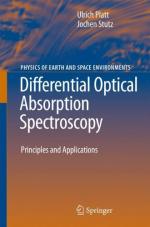|
This section contains 681 words (approx. 3 pages at 300 words per page) |

|
Absorption spectroscopy is a "workhorse" technology widely used in industry and in chemistry, biology, medicine, and other fields of scientific research. Numerous sciences, including chemistry and astronomy, have reached their current state of advancement only though use of absorption spectroscopic instruments.
Spectroscopy studies the way electromagnetic radiation interacts with matter. When radiation meets matter, the radiation is either scattered, emitted, or absorbed. This gives rise to three principal branches of spectroscopy. Emission spectroscopy observes light emitted by atoms excited by radiation/matter interactions. Raman spectroscopy monitors light scattered from molecules. Absorption spectroscopy studies radiation absorbed at various frequencies (wavelengths).
The roots of absorption spectroscopy can be traced to 1802, when the English chemist William Hyde Wollaston (1766-1828) observed what later became known as the Fraunhofer lines--the many dark lines seen in the spectrum of sunlight. In 1859, the German physicist Gustav Kirchhoff (1824-1887) determined that these lines resulted...
|
This section contains 681 words (approx. 3 pages at 300 words per page) |

|


